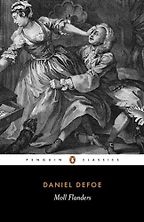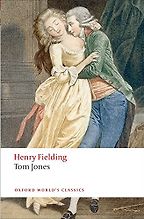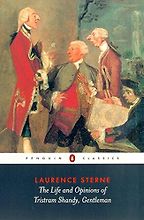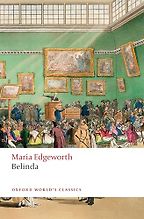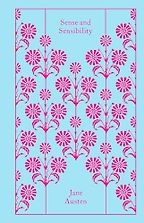Why read an 18th-century novel? Are these wonderful stories or are they more books you’d turn to if you’re interested in the history of the novel—because they’re regarded as some of the first in the English language?
I think it’s a bit of both. One of the great surprises of the 18th-century novel is that when you actually make yourself sit down and read one, they’re strangely fun. Especially Daniel Defoe, who really understood the art of the page turner – he basically invented it. And they still are page-turners. Moll Flanders is like a Jilly Cooper novel. Her adventures are so bizarre and extraordinary that you just keep reading. Belinda, another of the novels that I picked, is genuinely fascinating. It’s unbelievably strange and riveting. They can be a little bit off-putting to start with: don’t judge a book by its first chapter in the 18th century. But then they get fascinating.
And yes, they’re a good choice for anyone who is a serious reader and wants to think about where novels might have come from. Novels haven’t always existed, and of all the major literary forms, they are the newest. They got invented in about 1700 and what you see as you read novels across the 18th century is people learning how to write them and read them. At the close of the century you end up with Jane Austen, who turns the corner on how to write a novel in a way that no one’s ever changed. The form changes, but the basics are there.
What I liked in these 18th-century novels is the sense that I’m engaged in a slightly illicit activity. Nowadays, literary novels are regarded as very worthy and important, but in the 18th century, it seems like you’re doing something naughty by reading them.
It’s totally true. When Robinson Crusoe came out in 1719—which most people say is the first novel in English—it was a scandalous production. There were debates in the press for years about whether it was bad for you to read it. Someone called it “a palpable lie from beginning to end”—which is basically what we now know that novels are. These days, a palpable lie in fiction is a good thing, but at the time, people were really worried.
What they worried about was that you might get confused between the world of fiction and the world of reality—and not be able to tell them apart. But even back then, people were quite skilled in reading fiction. It’s funny to think about that now because questions of blurring the line between truth and fiction have come up again in the media. We’ve had these debates many times before about whether false facts are dangerous (which they are, unless they’re clearly announced as fiction).
Jane Austen does this impassioned defense of novels in Northanger Abbey, where she writes, “‘Oh! It is only a novel!…It is only Cecilia, or Camilla, or Belinda’; in short, only some work in which the greatest powers of the mind are displayed, in which the most thorough knowledge of human nature, the happiest delineation of its varieties, the liveliest effusions of wit and humour, are conveyed to the world in the best-chosen language.”
Let’s turn to the ones you’ve chosen and go through them in chronological order. You mentioned Moll Flanders by Daniel Defoe, which came out in 1722. It sets itself up as the autobiography of a woman, Moll Flanders, and I think originally Defoe didn’t even put his name on it, is that right?
Yes, his name wasn’t put on the book for several decades afterwards. The full title of the novel is The Fortunes and Misfortunes of the Famous Moll Flanders. So it’s trying to make the claim that it’s a true story, which is supposed to bring the punters in. But Defoe, from the outset, is always playing with the idea that people will know it’s a fiction; they won’t really think it’s true.
The novel is based on an actual woman called Moll King who was an accomplice of a well-known organized crime boss in the 18th century called Jonathan Wild. Defoe found out about Moll King when he was visiting a journalist he’d collaborated with in Newgate Prison in the late 1710s. Moll King was irrepressible. She was constantly committing crimes—I think she was sentenced to transportation to America four times and went twice. On both occasions, she came back, which was illegal. She was also constantly making new marriages.
Defoe adapted this story for Moll Flanders, which is the story of a woman who is born in Newgate Prison, where her mother was a prisoner, and goes on to lead a life of crime. What’s groundbreaking about Moll Flanders is that even though Moll is a criminal, a prostitute, a swindler, and a total scoundrel, she’s depicted as a kind of genius entrepreneur. She turns crime into a business, and she turns marriage into a business as well, always upgrading from one husband to another. She scatters illegitimate children across the globe. At one point, she even marries her half-brother. There’s a real interest in incest in the 18th century, and Moll Flanders is one of the novels it comes up in.
Then, eventually, she returns to America and has a happy reunion with the one husband that she truly loved and makes lots of money. You could make the claim that Moll Flanders is one of the early feminist texts.
Yes, because she’s very likable.
She’s very likeable. She has huge amounts of energy and no mental health issues. She doesn’t seem to suffer from anxiety at all.
In the edition of Moll Flanders I read, there were no chapters. It made me realize how helpful chapters are, those little pauses in the narrative so you can have a breather. Is that normal – were there no chapters yet at that point?
Defoe recognized as early as Robinson Crusoe that he had to figure out how to break stories up into manageable units, and he did come up with ways to divide up the book, into his journal, into different locations he visits, and so on. But the idea of the chapter as a formal convention of novels hadn’t really kicked in. That actually comes with Tom Jones…
Yes, let’s go on to Tom Jones, which came out in 1749 and is by Henry Fielding. Not only is this a great 18th century novel, it was one of my father’s all-time favorite novels—and I don’t think he’s the only one. For those who don’t know it, tell us a bit about it.
People love Tom Jones because it’s hilarious. It’s the great mid-century novel. It’s intimidatingly long, but it’s another page-turner.
It’s about an illegitimate foundling called Tom Jones, who gets adopted by the lovely, benevolent Squire Allworthy. Tom has a heart of gold, but he’s a total ne’er do well, and he’s always getting himself into scrapes. He has an evil half-brother called Blifil and one of the great tensions of the novel is, will Blifil’s misdeeds be discovered? Is Tom or Blifil going to end up with the upper hand?
Tom is constantly taking lovers. He’s irresistible to women, especially older women. There’s a society woman in London who takes him on, so he’s a kept man. At one point, it seems he is in a love affair with his own mother, though she turns out not to be. Meanwhile, he declares his passionate devotion to Sophia Western, a neighbouring squire’s daughter, who is the heroine of the novel. Sophia is a delightful creature based on Fielding’s wife, who died before the novel was written.
In pursuit of Sophia, and in Tom’s attempts to flee his home after he’s thrown out for drunken debauchery, he travels around England. So it’s a peripatetic novel that shows us England in the mid-century.
The novel itself is really fun, but what’s fascinating about it is this depiction of England in flux in the middle of the 18th century. There is a huge amount of forced migration from land enclosures, from the European wars, and from the Jacobite rebellions that are going on. There are gypsies—Romani travelers from Central Europe—in the novel, there are vagrants and beggars. We have this full picture of the ways in which property and vagrancy law and international wars were creating this highly volatile social fabric in England.
Plus there are lots of brilliant jokes about food…The book opens with a long riff about how authors are like restaurateurs serving up meals to fussy, discontented customers, who if they don’t like what they’re given to eat will “damn their dinner without control.” He sounds like someone complaining now about the comments they get on social media—Fielding was very ahead of his time.
Let’s turn to Tristram Shandy from 1759. The full title is The Life and Opinions of Tristram Shandy, Gentleman and it’s by Laurence Sterne, who was, surprisingly, a cleric.
Tristram Shandy comes out only nine years after Tom Jones, but it really turns the novel on its head. It’s a massive turning point and the first experimental masterpiece. As it says in the film of Tristram Shandy, it’s a post-modern novel “before there was any modernism to be post about.” The movie is amazing, by the way. It’s directed by Michael Winterbottom.
It’s ostensibly an (auto)biography, like Moll Flanders or Tom Jones, but it refuses ever to get to the life of the subject. The birth of Tristram Shandy and his actual development as an adult are constantly being hijacked by stories about his parents, about his uncle, Toby, who’s a very charismatic veteran from a war in Europe. There’s also Toby’s servant, the Corporal Trim, who’s a funny character, and the local obstetrician, Dr Slop. There’s Susannah, the maidservant, and Parson Yorick, who’s a very famous, colourful character. There are endless digressions with lots of sex jokes, like when Tristram gets an accidental circumcision after a window sash falls on him when he’s a child. It was denounced as highly scandalous and shocking at the time, including by Samuel Johnson, who famously said, “nothing so odd will do long.”
But Johnson was wrong, because at the heart of it—among all the silliness and the digression—is this deep sense of the feelings and emotional roller coaster of being a human. Sterne innovates the post-modern novel, but he also innovates what was called ‘the sentimental novel’—novels that give us this deep snapshot of a person’s inner life as they experience it themselves, and which doesn’t necessarily match up with their outer life. It’s about the way in which we all have these profound emotional and unconscious impulses that we’re aware of—or dimly aware of—but which are very hard to communicate or make known to the world. That was what Sterne figured out how to do, to show people’s innermost souls in all their turbulence and chaos.
So Tristram Shandy is both funny and outrageous and, frankly, quite hard to read, but it is also incredibly moving. You learn about someone’s struggle to be the hero of their own life, as he puts it.
That’s really interesting because with the stream of consciousness elements and apparent references to John Locke, this was the novel I found hardest to get through. You’re saying to persevere because, ultimately, it’s very moving?
It’s very moving. It does take some tenacity, but there are passages about what it means to be human that are incredibly real and vivid. It’s about loving people, about having parents, about being a child. All these relationships are being explored for the first time through the lens of a person’s individual consciousness. That’s the link to Locke—plus the association of ideas, which gives Sterne license to make these wild leaps and links between unconnected things.
Let’s go on to Belinda by Maria Edgeworth, which was published right at the edge of the 18th century, in 1801.
Yes, my last two choices only just sneak in. They were both drafted solidly in the 18th century, so that’s my justification.
Maria Edgeworth was both a great novelist in her own right and a major influence on Jane Austen. She was Anglo-Irish, so she was thinking about the colonial relationship between Britain and Ireland. Belinda also coincides with the acceleration of abolitionism in England and is one of the first novels in English to depict an interracial marriage. There were two older books that touched on inter-racial relationships: Oroonoko by Aphra Behn in the late 17th century, which is a pseudo-novel, and a little-known novel by Eliza Haywood called The Adventures of Eovaai, which is a sort of Orientalist fantasy. In Belinda, and English farm girl called Lucy marries Juba, who is a Black servant from the West Indies.
Belinda herself, the heroine, almost marries a Creole man from the West Indies called Mr. Vincent. So Edgeworth, partly because she’s Irish, partly because of the period in which she’s writing, is thinking about the impact of imperialism and colonialism on the state of the world, and she’s really opening up the possibility of interracial marriage, which is very radical.
The other amazing part of the book is the character of Lady Delacour, who is this fascinating aristocratic woman who thinks she has breast cancer for two-thirds of the novel. A bit like in the Sterne novel, we see the inner torment of someone who believes herself to be dying. Part of what’s so brilliant about the way Edgeworth tells the story is that it’s always quite opaque. We never fully understand what’s happening. I think that reflects Lady Delacour’s sense that she can’t communicate the extremity of her fear and vulnerability to the world.
There’s this extraordinary scene where she reveals what she believes to be her tumorous breast to Belinda, the heroine. Everything in the novel has this slight quality of possible fantasy or speculation about it. How do you blur the line between what’s really happening on the page and what the characters are just imagining?
There’s also a character called Anne Percival, who’s an older woman in the novel. Edgeworth is experimenting not just with representing women, but women in phases of life that no one’s previously been particularly interested in.
The last thing to point out is that in the list in Northanger Abbey—where Austen defends the novel as this incredibly important form—she belatedly added Belinda. She mentions two novels by Fanny Burney and then added Maria Edgeworth. And rightly so.
Belinda is a page turner. I’ve made it sound a bit too worthy, and I’ve been calling attention to what’s interesting from a literary history point of view, but it’s first and foremost a great read.
Finally, let’s talk about Jane Austen and her novel, Sense and Sensibility. Tell me why you chose it.
It’s Jane Austen’s 250th birthday this year, so I had to include an Austen novel. It was published in 1811, but she wrote it during the 1790s and probably started writing it when she was 18 or 19. The thing about Sense and Sensibility—and anyone who’s seen the Ang Lee film will also know this—is that it doesn’t read like a Jane Austen novel. It’s incredibly passionate and overwrought and full of intensity of feeling.
It’s organized around two sisters, Elinor and Marianne. Theoretically, Elinor is the more restrained one. She has ‘sense’—she’s the rational, reasonable one. Marianne is the overwrought, hyper-emotional one. But actually, when you read the novel, what you realize is they both have equally intense, tortured personal lives. It’s not light and bright like Pride and Prejudice: it’s quite a dark novel.
It’s still very fun, and it’s got social satire, but the condition of the women in the novel is of suffering and anguish at the hands of men who treat both of them incredibly badly. They’re given happy endings, but the driving force of the story is female suffering and the intensity and difficulty of female feeling that can’t really be recognized by the worlds that they’re living in.
It’s a beautiful novel. It has a depth and complexity to it that Pride and Prejudice also has, but as Jane Austen said of Pride and Prejudice, “it wants shade”. Sense and Sensibility has that shade and so to read it alongside Pride and Prejudice is an amazing experience. In many ways, they’re the same story: of two sisters who are almost prevented from marrying men that they love but it all comes right in the end. The Sense and Sensibility version of it is very melancholic, with disaster hovering right there, and the Pride and Prejudice version is much more joyful and playful and Bridget Jones-like.
Austen drafted them both in the 1790s and then went through a period of huge turbulence when her family had to leave their house in Steventon, in Hampshire. After her father died, she had a period that’s been described as “genteel homelessness” for about 10 years. Then her brother, Edward Austen Knight, who’d been adopted by a wealthy family, gave her Chawton House, which is where they lived for the rest of her life. So Sense and Sensibility also tracks a period of huge precarity and anxiety in Austen’s life. It’s a stunning read. I highly, highly recommend it.
Yes, because I would say that starting with Belinda and especially with Sense and Sensibility, I no longer feel that I’m reading an 18th century novel. They feel much closer.
Yes, that’s an important point to make. They read like modern novels, and the characters feel modern. Belinda and Sense and Sensibility are the ones to start with, I would say. They’re a lot of fun.
One final pitch for 18th-century novels: if you’re serious about reading and you read through these five, you will see the novel’s evolution. There’s nothing in the modern novel—or even the post-modern novel—that isn’t in these early examples of the form. Writers obviously realized fairly early on that this play between the novel’s ability to get inside the mind and also stay outside it was crucial. The juxtaposition in early novels is about isolation and togetherness or community being in constant tension. I’d make the case that’s still what most novels are about today.
Interview by Sophie Roell, Editor
March 31, 2025. Updated: June 22, 2025
Five Books aims to keep its book recommendations and interviews up to date. If you are the interviewee and would like to update your choice of books (or even just what you say about them) please email us at [email protected]
Five Books interviews are expensive to produce. If you've enjoyed this interview, please support us by donating a small amount.


